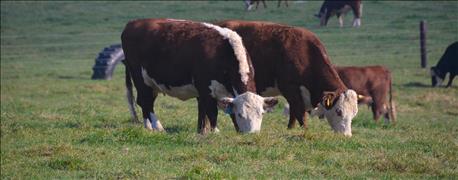
Sure, cattlemen are a tough, independent, tenacious bunch. But after the last few years of historic high prices, you may have to toughen up again.
Most experienced crystal-ball gazers predict that 2018 through 2020 will see the lowest cattle prices of the next five years. So with that far less optimistic five-year outlook, what can you do? As the boy scouts say, “Be prepared!” Your first step is to consider the effect of a half-dozen highly interrelated variables.
1. Try to manage volatility.
Your reaction to this point is undoubtedly: “What else is new? I’ve been dealing with volatility since I started!”

MORE TO CHEW ON: Improved pasture and stockpiled hay management may be one of the least-cost ways to reduce beef costs.
If a strong La Niña weather pattern arrives this fall, we may have widespread drought next year. Then there’s increasing political volatility — foreign and domestic. No one knows what impact the United Kingdom leaving the European Union will have on our beef exports. At home, both presidential candidates have strong opinions on global trade that could impact beef.
While we still have a dedicated group of buy-at-any-price beef eaters, increasing numbers will quickly jump to cheaper chicken or pork or fish if the price advantage is right. And there are those who increasingly want beef produced in a certain manner (i.e., all-natural, organic, grass-fed and humanely raised, etc.).
Finally, there’s cost volatility, as costs of input providers are slow to follow the cattle market back down.
Perhaps the best way to manage all this volatility is to be disciplined enough to set aside feed and profits during better times to make it through tougher times.
2. Are your cows oversized?
After years of talking “ideal” beef cow size, we’re no closer to a consensus. Most producers tend to underestimate the weight of their cows. Looking at breed association yearling weight trends and slaughter weights, cow size has been growing. You might be surprised at how many 1,500-pound-plus cows are lounging in your herd.
Heavier cows need more feed. So do they wean calves that pay for that extra input? A recent Wyoming study published in the Rangelands Journal found that 1,000-pound cows on a university ranch weaned more pounds of beef than other weight classes up to 1,400 pounds.
Since you can stock a greater number of lighter cows on an acre of grass, more total pounds of beef are produced per acre. One conclusion was that for every 100-pound increase in cow weight, you need about a 25-pound increase in weaning weight just to cover the extra feed cost of the larger cow.
While the moderate-sized 1,200- to 1,300-pound cow is generally recognized as desirable, it may or may not be best for your operation. One reason is the differing preferences among local feeder calf markets. But bigger cows need to be superior individuals to justify their feed requirements.
3. Shorten that calving season.
While it’s easier said than done, you shorten the calving season by shortening the breeding season. Your herd is easier to manage when a large percentage is at a similar stage of production. Your calf crop is more uniform, which simplifies marketing.
This goal requires sound year-around nutrition, excellent bull and/or AI management and exposing heifers earlier than the mature cows. You also must be willing to sell those late-calving females.
4. Size-up your competition!
Face it; it’s easy to get “barn blind” and think your herd performance is fine, especially if you keep little or no records. But benchmark data can be extremely useful in spotting specific areas needing improvement.
The largest U.S. cow-calf database — 88,000 cows — is North Dakota State University’s Cow Herd Appraisal of Performance Software program. How does your herd performance data stack up with the CHAPS summary below? These values tend to be good benchmarks to strive for since CHAPS-enrolled herds tend to be better managed than the average.
The calving distribution is a useful measure. Most producers find that those cows and heifers that calve early in your calving season tend to be the most profitable. Several specialists recommend striving for at least 60% of the herd calving during the first 21 days of the season. Those females would tend to be the most fertile. Weaning weights tend to decline significantly for calves born late in the season.
5. Face up to the VFD.
FDA’s veterinary feed directive kicks in on Jan. 1, 2017. Many small producers may still be ignoring the issue and will only realize its impact when they find they can’t buy a medicated feed product without written approval by their veterinarian.
If you haven’t done so already, call your local vet today and discuss this issue. Tell him or her which medicated products you typically use and for what purpose. Ask if they’ll feel comfortable providing you with needed, and soon mandatory, support.
6. Lower your production costs.
With potential revenues on the way down, the major way to maintain profitability is to lower production costs. Improving productivity via more pounds of calf weaned per cow exposed is one way.
Most studies show, however, that cost reduction is even more important. How’s that? The investment necessary to raise performance is often similar to the value of the extra gain realized.
Excellent pasture management allows you to use less stored and/or purchased feed. And, having cows that fit your operation’s environment can go a long way in minimizing production costs.
Harpster is a beef cow-calf producer and retired Penn State animal scientist.
About the Author(s)
You May Also Like




